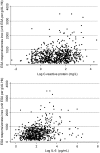Association of malnutrition-inflammation complex and responsiveness to erythropoiesis-stimulating agents in long-term hemodialysis patients
- PMID: 23045431
- PMCID: PMC3707522
- DOI: 10.1093/ndt/gfs368
Association of malnutrition-inflammation complex and responsiveness to erythropoiesis-stimulating agents in long-term hemodialysis patients
Abstract
Background: Protein-energy wasting, inflammation and refractory anemia are common in long-term hemodialysis patients. A decreased responsiveness to erythropoiesis-stimulating agents (ESA) is often the cause of the refractory anemia. We hypothesized that the malnutrition-inflammation complex is an independent predictor of decreased responsiveness to ESAs in hemodialysis patients.
Methods: This cohort study of 754 hemodialysis patients was examined for an association between inflammatory and nutritional markers, including the malnutrition-inflammation score (MIS) and responsiveness to ESA. Cubic spline models were fitted to verify found associations.
Results: The mean (±SD) age of patients was 54 ± 15 years, 53% were diabetic and 32% blacks. MIS was worse in the highest quartile of ESAs responsiveness index (ERI, ESA dose divided by hemoglobin) when compared with 1st quartile (6.5 ± 4.5 versus 4.4 ± 3.4; P < 0.001). Both C-reactive protein (log CRP) (β = 0.19) and interleukin-6 (log IL-6) (β = 0.32) were strong and independent predictors of ERI using multivariate linear regression. Serum albumin (β = -0.30) and prealbumin levels (β = -0.14) were inversely associated with ERI. Each 1 SD higher MIS, higher CRP and lower albumin were associated with 86, 44 and 97% higher likelihood of having highest versus three lowest ERI quartiles in fully adjusted models [odds ratio (and 95% confidence interval) of 1.86 (1.31-2.85), 1.44 (1.08-1.92) and 1.97 (1.41-2.78)], respectively. Cubic splines confirmed the continuous and incremental nature of these associations.
Conclusions: Malnutrition-inflammation complex is an incremental predictor of poor responsiveness to ESAs in hemodialysis patients. Further studies are needed to assess whether modulating inflammatory or nutritional processes can improve anemia management.
Keywords: erythropoietin-stimulating agent (ESA) therapy; hemoglobin; inflammatory marker; malnutrition–inflammation complex; responsiveness to ESAs.
Figures


References
-
- Kalantar-Zadeh K, Kopple JD, Block G, et al. A malnutrition–inflammation score is correlated with morbidity and mortality in maintenance hemodialysis patients. Am J Kidney Dis. 2001;38:1251–1263. doi:10.1053/ajkd.2001.29222. - DOI - PubMed
-
- Kaizu Y, Ohkawa S, Odamaki M, et al. Association between inflammatory mediators and muscle mass in long-term hemodialysis patients. Am J Kidney Dis. 2003;42:295–302. doi:10.1016/S0272-6386(03)00654-1. - DOI - PubMed
-
- Maruyama Y, Nordfors L, Stenvinkel P, et al. Interleukin-1 gene cluster polymorphisms are associated with nutritional status and inflammation in patients with end-stage renal disease. Blood Purif. 2005;23:384–393. doi:10.1159/000087196. - DOI - PubMed
-
- Balakrishnan VS, Guo D, Rao M, et al. Cytokine gene polymorphisms in hemodialysis patients: association with comorbidity, functionality, and serum albumin. Kidney Int. 2004;65:1449–1460. doi:10.1111/j.1523-1755.2004.00531.x. - DOI - PubMed
-
- Raj DS, Dominic EA, Pai A, et al. Skeletal muscle, cytokines, and oxidative stress in end-stage renal disease. Kidney Int. 2005;68:2338–2344. doi:10.1111/j.1523-1755.2005.00695.x. - DOI - PubMed
Publication types
MeSH terms
Substances
Grants and funding
- K23 DK61162/DK/NIDDK NIH HHS/United States
- R21 DK078012/DK/NIDDK NIH HHS/United States
- P20 MD00182/MD/NIMHD NIH HHS/United States
- KL2 TR000122/TR/NCATS NIH HHS/United States
- U54 MD007598/MD/NIMHD NIH HHS/United States
- R01 DK078106/DK/NIDDK NIH HHS/United States
- P20 MD000182/MD/NIMHD NIH HHS/United States
- K24 DK091419/DK/NIDDK NIH HHS/United States
- S21 MD000103/MD/NIMHD NIH HHS/United States
- RR026138/RR/NCRR NIH HHS/United States
- U54 RR026138/RR/NCRR NIH HHS/United States
- K23 DK061162/DK/NIDDK NIH HHS/United States
- UL1 TR000124/TR/NCATS NIH HHS/United States
LinkOut - more resources
Full Text Sources
Medical
Research Materials
Miscellaneous

